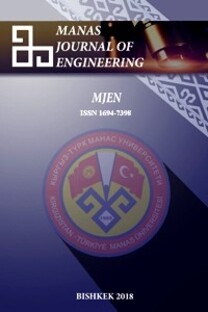Prediction of the formation of low-molecular components, particles, and condensed phases during thermal destruction of oil-contaminated soil
oil, soil, carbon, metal, chemical composition, component, particle, thermodynamics, modeling, condensed phase, neutralization.
Prediction of the formation of low-molecular components, particles, and condensed phases during thermal destruction of oil-contaminated soil
oil, soil, carbon, metal, chemical composition, component, particle, thermodynamics, modeling, condensed phase, neutralization,
___
- Ding D., Song X., Wei C., LaChance J. A review on the sustainability of thermal treatment for contaminated soils. Environmental Pollution, 253, (2019), 449-463.
- Vidonish J. E., Alvarez P. J., Zygourakis K. Pyrolytic Remediation of Oil-Contaminated Soils: Reaction Mechanisms, Soil Changes, and Implications for Treated Soil Fertility. Industrial & Engineering Chemistry Research, 57(10), (2018) 3489–3500.
- Bykova M.V., Pashkevich M.A.. “Engineering and ecological survey of oil-contaminated soils in industrial areas and efficient way to reduce the negative impact” in Scientific and Practical Studies of Raw Material Issues. 1st Ed, ImprintCRC Press. 2019.
- Kemelov K., Maymekov U., Sambaeva D., Maymekov Z. Reducing concentrations of Benzo (a) pyrene in gas phase soot particles by using and burning water fuel emulsions. Polish Journal of Environmental Studies, 29(4), (2020), 2669-2677.
- Ossai I. C., Ahmed A., Hassan A., Hamid, F. S. Remediation of soil and water contaminated with petroleum hydrocarbon: A review. Environmental Technology & Innovation, Volume, 17, (2020), 100526
- Zivdar Z., Heidarzadeh N., Asadollahfardi G. Remediation of diesel-contaminated soil by low-temperature thermal desorption. Int. J. Environ. Sci. Technol., 16, (2019), 6113–6124.
- Lee T., Nam I.-H., Kim J.-H., Zhang M., Jeong T. Y., Baek K., Kwon E.E. The enhanced thermolysis of heavy oil contaminated soil using CO2 for soil remediation and energy recovery. Journal of CO2 Utilization, 28, (2018), 367–373.
- Sang Y., Yu W., He L., Wang Z., Ma F., Jiao W., Gu Q. Sustainable remediation of lube oil-contaminated soil by low temperature indirect thermal desorption: Removal behaviors of contaminants, physicochemical properties change and microbial community recolonization in soils. Environmental Pollution, 287, (2021), 117599.
- Lee S. H., Kim S. O., Lee S. W., Kim M. S., Park H. Application of Soil Washing and Thermal Desorption for Sustainable Remediation and Reuse of Remediated Soil. Sustainability, 13(22), (2021), 12523.
- He L., Sang Y., Yu W., Lu T., Wang F., Ma F., Jiao W. Sustainable remediation of dibenzofuran-contaminated soil by low-temperature thermal desorption: Robust decontamination and carbon neutralization. Chemosphere, 302, (2022), 134810.
- Li Y., Wei M., Yu B., Liu L., Xue Q. Thermal desorption optimization for the remediation of hydrocarbon- contaminated soils by a self-built sustainability evaluation tool. Journal of Hazardous Materials, (2022), 129156.
- Bykova M.V., Alekseenko A.V., Pashkevich M.A., Drebenstedt C. Thermal desorption treatment of petroleum hydrocarbon-contaminated soils of tundra, taiga, and forest steppe landscapes. Environmental Geochemistry and Health, 43(6), (2021), 2331–2346.
- Baymanov G. "Scientists of the Kyzylorda State University named after Korkyt-Ata have developed a method for cleaning oil-contaminated areas in an arid hot climate" 08/05/2017 Kyzylorda, Kazakhstan. https://www.kt.kz/rus/science/kizilordinskie_uchenie_usovershenstvovali_metod_ochistki_neftezagrjaznen nih_territorij_1153644002.html https://www.kt.kz [Accessed: 20 Sept. 2022].
- Dzhusipbekov U.Zh., Nurgalieva G.O., Kuttumbetov M.A., Zhumasil E., Duisenbay D., Suleimenova O.Ya. Pilot- industrial testing of the process of processing oil-contaminated soil, Chemical Journal of Kazakhstan, 3, (2015), 234-240. (in Russian)
- Dzhusipbekov U.Zh., Nurgaliyeva G.O., Kuttumbetov M.A., Zhumasil E. “Neutralization of oil-contaminated soil using humate-based energy-accumulating substance” Materals Vserossiyskoy scientific and practical. conference- Nizhnekamsk, 1, 88-89, 2015. (in Russian)
- Dzhusipbekov U.Zh., Nurgalieva G.O., Bayakhmetova Z.K., Aizvert L.G. Determination of the hazard class of contaminated and neutralized soil - Chemical Journal of Kazakhstan - Almaty, 1 (65), (2019), 37-49 (in Russian)
- Dzhusipbekov et al. Physical and chemical bases for the restoration of oil-contaminated and disturbed soils-Almaty, 1, (2022), 162-169 (in Russian)
- Trusov B. G., Badrak S. A., Turov V. P., Baryshevskaya I. M. Automated system of thermodynamic data and calculations of equilibrium states. Mathematical methods of chemical thermodynamics, Novosibirsk: Nauka, (1982), 213-219. (in Russian)
- Badrul I. Petroleum sludge, its treatment and disposal: a review. Int. J. Chem. Sci.13(4), (2015), 1584-1602.
- Krzhizh L., Reznik D. Technology of cleaning the geological environment from oil pollution. Ecology of production, 10, (2007), 54. (in Russian)
- Ivanov A.A., Yudina N.V., Maltseva E.V., Matis E.Ya. Study of biostimulating and detoxifying properties of humic acids of various origins in oil-contaminated soil. Chemistry of vegetable raw materials, 1, (2007), 99- 103. (in Russian)
- Kolbasov G.A. “Assessment of the possibility of using industrial humates in the biological reclamation of oil-contaminated peat soils”. Dissertation, 03.02.13. – M.: Moscow State University. M.V. Lomonosov, 2011 (in Russian)
- ISSN: 1694-7398
- Yayın Aralığı: 2
- Başlangıç: 2001
- Yayıncı: KIRGIZİSTAN-TÜRKİYE MANAS ÜNİVERSİTESİ
Umirzak DZHUSİPBEKOV, Dametken FİSCHER, Gulzipa NURGALİEVA, Kubat KEMELOV, Damira SAMBAEVA, Zarlık MAYMEKOV
